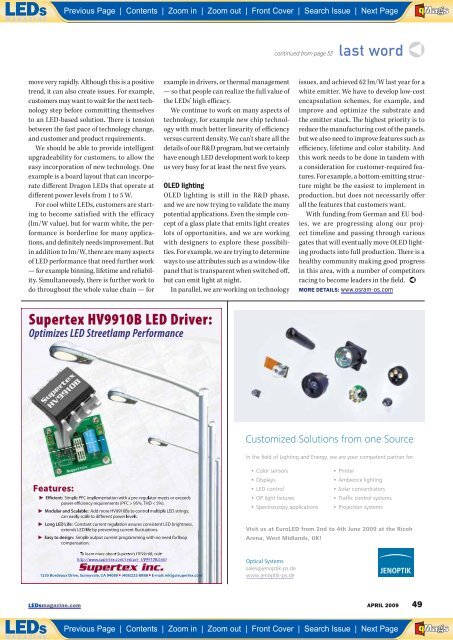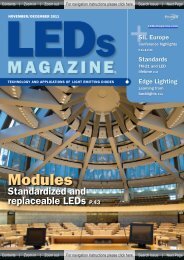Zoom In - Beriled
Zoom In - Beriled
Zoom In - Beriled
- No tags were found...
You also want an ePaper? Increase the reach of your titles
YUMPU automatically turns print PDFs into web optimized ePapers that Google loves.
Previous Page | Contents | <strong>Zoom</strong> in | <strong>Zoom</strong> out | Front Cover | Search Issue | Next PageABE FMaGScontinued from page 52last wordmove very rapidly. Although this is a positivetrend, it can also create issues. For example,customers may want to wait for the next technologystep before committing themselvesto an LED-based solution. There is tensionbetween the fast pace of technology change,and customer and product requirements.We should be able to provide intelligentupgradeability for customers, to allow theeasy incorporation of new technology. Oneexample is a board layout that can incorporatedifferent Dragon LEDs that operate atdifferent power levels from 1 to 5 W.For cool white LEDs, customers are startingto become satisfied with the efficacy(lm/W value), but for warm white, the performanceis borderline for many applications,and definitely needs improvement. Butin addition to lm/W, there are many aspectsof LED performance that need further work— for example binning, lifetime and reliability.Simultaneously, there is further work todo throughout the whole value chain — forexample in drivers, or thermal management— so that people can realize the full value ofthe LEDs’ high efficacy.We continue to work on many aspects oftechnology, for example new chip technologywith much better linearity of efficiencyversus current density. We can’t share all thedetails of our R&D program, but we certainlyhave enough LED development work to keepus very busy for at least the next five years.OLED lightingOLED lighting is still in the R&D phase,and we are now trying to validate the manypotential applications. Even the simple conceptof a glass plate that emits light createslots of opportunities, and we are workingwith designers to explore these possibilities.For example, we are trying to determineways to use attributes such as a window-likepanel that is transparent when switched off,but can emit light at night.<strong>In</strong> parallel, we are working on technologyissues, and achieved 62 lm/W last year for awhite emitter. We have to develop low-costencapsulation schemes, for example, andimprove and optimize the substrate andthe emitter stack. The highest priority is toreduce the manufacturing cost of the panels,but we also need to improve features such asefficiency, lifetime and color stability. Andthis work needs to be done in tandem witha consideration for customer-required features.For example, a bottom-emitting structuremight be the easiest to implement inproduction, but does not necessarily offerall the features that customers want.With funding from German and EU bodies,we are progressing along our projecttimeline and passing through variousgates that will eventually move OLED lightingproducts into full production. There is ahealthy community making good progressin this area, with a number of competitorsracing to become leaders in the field.MORE DETAILS: www.osram-os.com_____________________________LEDsmagazine.com APRIL 2009 49Previous Page | Contents | <strong>Zoom</strong> in | <strong>Zoom</strong> out | Front Cover | Search Issue | Next PageABE FMaGS

















